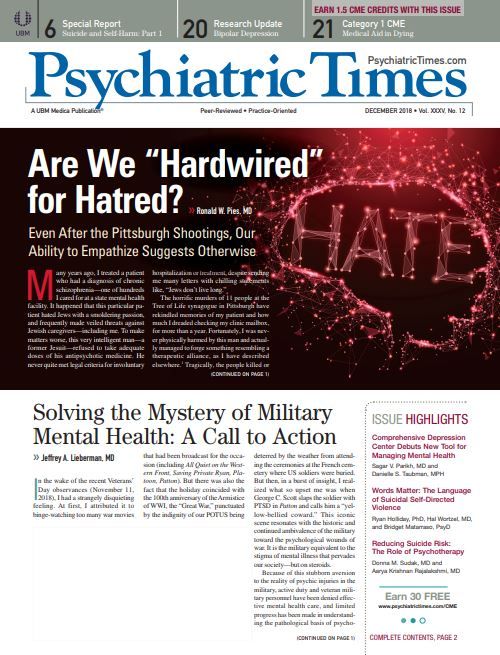Publication
Article
Psychiatric Times
Introduction: Turning Suicide Prevention Science Into Action
Author(s):
Even while attitudes are opening up about mental health and suicide prevention, the rate of suicide continues to rise in the United States.
MOTORTION/AdobeStock

A National Imperative
We are living in a pressing time of transition in our nation. Even while attitudes are opening up about mental health and suicide prevention, the rate of suicide continues to rise in the United States, in fact by nearly 30% over the past two decades.1 After a century of progress as a nation, overall mortality particularly in the middle years is increasing as a result of the so-called deaths of despair due to suicide, alcohol, opioids, and liver disease.2 In an era with greater technologic advances and potential connectivity, the science of suicide demonstrates that many forces are still active, including human experiences of isolation, struggle, loss, and unmet expectations, and concurrently, low mental health literacy. Although 94% of US adults believe mental health is equally important to physical health, most do not know how to identify changes in mental health that signal serious risk, or what to do in response, let alone have feasible access and mental health coverage anywhere near parity.3
Additionally, overreliance on a sense of self-sufficiency and fear of judgment are barriers to achieving deeper connections in our relationships and fully integrating suicide prevention into actionable steps in our homes and communities. The truth is that interpersonal connectivity is a basic need for humans. When we lose that experience of connection, whether due to changes in culture and modern frenetic living or shame that drives people to hide their true internal experiences, then the prevalent experience of unaddressed mental health conditions and other types of suffering can lead to the problems we are seeing in the rising suicide rate.
We must be ready for the fact that all of us as members of the human condition will face incredible challenges, at times pushing beyond our own sense of capability in a given moment. Most will experience varying degrees of isolation. The full continuum of mental health spans a wide range from joy to terrible anguish, and ambivalence between hope and hopelessness (and many other risk factors for suicide) is fairly common human experiences. If we can learn to discuss these human experiences without shame, we can become more sophisticated at recognizing the potential avenues for effective intervention to lead a person in trouble down a healthier path. Additionally, by sharing these experiences more freely with trusted others, our sense of connectedness can lead to better health outcomes in many arenas including suicide risk reduction.
Imagine a society in which a common, basic understanding of neuroplasticity and epigenetics are fact, not fiction, informing a more compassionate, trauma-informed approach to K to 12 education and workplace wellness. With this basic, foundational knowledge of neuroscience, children and adults can be taught strategies that protect and enhance cortical brain development, prevention for psychiatric illness can start early, and suicide prevention can be built into every school and pediatric clinic. Envision a society in which front-line citizens (eg, first responders, teachers, health professionals, legal/financial advisors, probation/corrections officers, addiction counselors) are trained in basic mental health first aid and suicide prevention; in which we move beyond stigma related to distress or suicide loss; and in which the RAISE early prevention/intervention model is applied to prodromal or burgeoning mental illness with treatment and self/family strategies as part of recovery.4 Further, envision a society in which biomarkers for suicide and predictive analytics are further refined and scaled to national level so that every patient in primary care has the benefit of mental health screening and suicide preventive interventions, as they do for other leading causes of death (eg, cardiovascular disease, cancer, infectious diseases).5,6 Finally, envision a society in which health systems have become suicide-safer systems of care.7
These advances are at various stages of progress. New recommended care standards were recently released for better detection and clinical care that reduces suicide risk.8 At the American Foundation for Suicide Prevention, we fund research, provide community education, and serve as a catalyst for cultural transformation and suicide rate reduction through initiatives like Project 2025.9 We remain hopeful because we see the seeds of change glimmering around the US. Through the leadership of our scientific community and our delivery mechanism for education, advocacy, and loss support through a chapter network in all 50 states, we see that suicide prevention is not only possible, but the foundation is being built. We must all work together in the field of psychiatry with partners of many types, including health system leaders, tech and corporate leaders, media, education, and policy makers, to mount the effective suicide prevention plan that is necessary to stem this rising tide.
In this Special Report, new developments and current thinking in suicide prevention are presented, including:
• Recommended language changes that can speed the eradication of stigma (eg, the recommendation to stop using the phrase “commit suicide” because suicide is a complex health outcome, not a moral failing)
• One physician’s powerful personal experience of suicide loss and lived experience that has led to newfound freedom
• Treatment modalities with evidence for reducing suicide risk in high-risk patient populations: cognitive behavioral therapy for suicidal cognitions and behaviors, dialectical behavior therapy for adults with borderline personality disorder and for adolescents with elevated suicide risk, among other modalities
• New methods in suicide prevention research aimed at better risk detection
• An approach to clinical suicide risk assessment that incorporates underutilized tools like the Reasons for Living Inventory
• Integration of suicide prevention practices into primary care
• A health system framework called Zero Suicide that specifically aims to better identify at-risk patients and provide the warm handoff and care, follow-up contact, and evidence-based treatment that can save lives
• Research about the impact of media and social media in particular related to mental health and suicide prevention
Suicide prevention is a complex challenge, but we remain resolute. The nation’s readiness for effective pro-mental health and suicide prevention strategies is growing like never before, and the scientific field of suicide has matured enough to provide answers. In this issue and the next issue, we share highlights from the growing science. We don’t have time to waste. Let’s speed the bench to bedside translation and work together to reduce suicide in the US.
Disclosures:
Dr Moutier is Chief Medical Officer, American Foundation for Suicide Prevention, New York, NY. Dr Moutier reports no conflicts of interest concerning the subject matter of this Special Report.
References:
1. Stone DM, Simon TR, Fowler KA, et al. Vital signs: trends in state suicide rates – United States, 1999-2016 and circumstances contributing to suicide – 27 states, 2015. MMWR Morb Mortal Wkly Rep. 2018;67:617-624.
2. Case A, Deaton A. Rising morbidity and mortality in midlife among white non-Hispanic Americans in the 21st century. Proc Natl Acad Sci USA. 2015;112:15078-15083.
3. American Foundation for Suicide Prevention. National survey shows majority of Americans would take action to prevent suicide. September 12, 2018. https://afsp.org/harrispoll/. Accessed November 6, 2018.
4. Dixon LB, Goldman HH, Srihari VH, Kane JM. Transforming the treatment of schizophrenia in the United States: the RAISE initiative. Annu Rev Clin Psychol. 2018;14:237-258.
5. Oquendo MA, Sullivan GM, Sudol K, et al. Toward a biosignature for suicide. Am J Psychiatry. 2014;171:1259-1277.
6. Walsh CG, Ribeiro JD, Franklin JC. Predicting risk of suicide attempts over time through machine learning. Clin Psychol Sci. 2017;5:457-469.
7. Suicide Prevention Resource Center. Zero Suicide in Health and Behavioral Healthcare. https://www.zerosuicide.sprc.org/. Accessed November 6, 2018.
8. National Action Alliance for Suicide Prevention: Transforming Health Systems Initiative Work Group. Recommended standard care for people with suicide risk: making health care suicide safe. Washington, DC: Education Development Center, Inc.; 2018.
9. American Foundation for Suicide Prevention. Project 2025. www.afsp.org/project2025. Accessed November 6, 2018.







